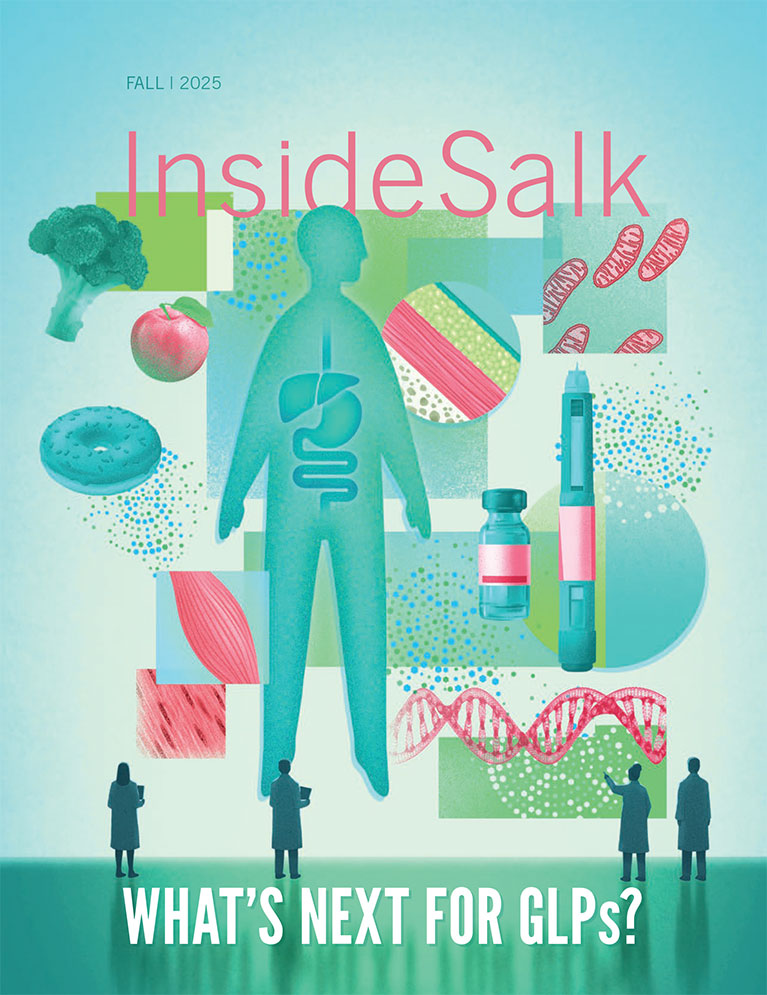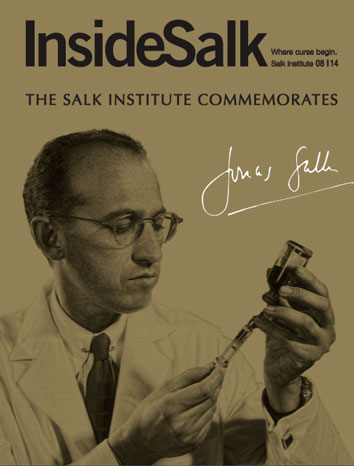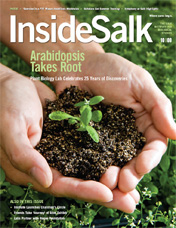Frontiers Journey of a lifetime The Cancer Center at Salk celebrates 50 years of life-changing discoveries
When Professor Reuben Shaw was in graduate school at MIT, a half-dozen years before he came to the Salk Institute, he was a groomsman in the wedding of his best friend from college. On the couple’s arrival in Hawaii from Massachusetts for their honeymoon, the bride complained to the groom of a pounding headache. It turned out to be glioblastoma, a deadly brain cancer. Three years later, Shaw was a pallbearer at her funeral.
Even though Shaw was himself already a cancer researcher, this was his first personal experience with the devastating disease.
“It was just so cruel and disheartening because I already had dedicated my life to working on cancer. But the inability to change a thing couldn’t have been more stark than watching the experience of my dear friend and his lovely wife,” says Shaw.
Today, Shaw is working to change a lot of things about cancer as director of the National Cancer Institute-designated Cancer Center at Salk, which turns 50 this year.
In that time, the Cancer Center has become a powerhouse of critical discoveries that have led to treatments and remissions for patients. Sixty percent of Salk’s faculty are members of the Center, and more than half of the Institute’s research focuses on cancer. But cancer is still the second-leading cause of death in the United States, after heart disease, and the Centers for Disease Control and Prevention projects that cancer rates will increase by almost 50 percent by 2050. So the Center’s mission, to make current generations the last to see cancer as anything other than a routine diagnosis, remains an urgent one.
Because scientific discoveries take time to be translated into therapies, there is no room for complacency—yet there is plenty of room for hope. Over the five decades since Salk’s Cancer Center was established, the scientific and medical community has traveled an almost unimaginable distance in its understanding of cancer. And Salk, as always, has been ahead of the curve.




Few words have the power to evoke such fear and dread as the word “cancer.” This disease of voracious cell growth has been with humans for all of recorded history, and likely much longer. For most of that time, little was understood about how it developed and effective treatments were nonexistent. But in the 20th century, that changed dramatically.
In the 1950s, scientists identified DNA as the hereditary blueprint of cells. It didn’t take many more years for them to connect DNA changes within cells to the development of cancerous tumors. One of the key figures for that discovery was Renato Dulbecco, an Italian physician-scientist who emigrated to the US after World War II to study viruses.
As a researcher at Caltech, he and fellow physician-scientist Marguerite Vogt discovered that some viruses can transfer their DNA into cells and cause them to become cancerous, a discovery for which Dulbecco would win a Nobel Prize in 1975. For the first time, scientists knew what caused cancer: rogue DNA. Researchers would soon begin discovering how cancer-causing DNA didn’t only come from outside of cells—via sources like viruses—but cells’ own DNA could undergo mutations that started them on the path to cancer. Dulbecco early on realized the importance—to health and disease—of cataloging every human gene, and was the first person to suggest a project to sequence the entire genome, an effort that became the Human Genome Project. That effort, completed in 2003, helped identify numerous cancer-causing genes.


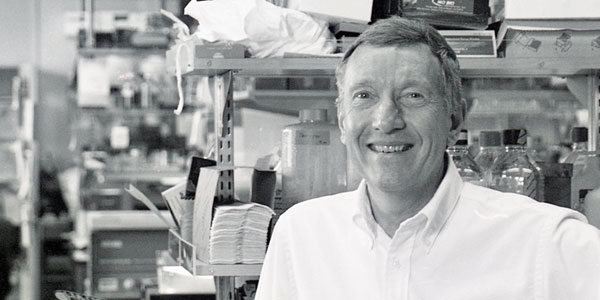

Dulbecco moved his lab to the Salk Institute in 1963—the year the Institute’s doors opened—accompanied by Vogt. With the arrival of cell biologist Walter Eckhart and biochemist Robert Holley a few years later, Salk would become a new hub of impactful cancer research.
Eckhart, who died in June 2022, began working as a postdoctoral fellow with Dulbecco in 1965, and in 1969 became one of the Institute’s first assistant professors. (See the tribute to Eckhart in the Winter 2022 issue of Inside Salk.) Eckhart studied the regulation of cell growth, including the effects of cancer-causing genes, known as oncogenes.
“It was exciting to work around the clock and to be part of experiments that solidified the idea that genes could be instrumental in provoking cancer,” Eckhart told Inside Salk in a 2012 memorial to Dulbecco. “At the time, a lot of us didn’t quite appreciate the magnitude of what we were living. There was a lot to know and to discover.”
Holley, a professor at Cornell University for most of his career, took a sabbatical at Salk in 1966-67 to study the growth of mammalian cells. In 1968, Holley won a Nobel Prize for earlier work contributing to the understanding of how DNA guides protein synthesis. That same year, he was awarded a lifetime American Cancer Society Professorship, and moved his lab permanently to the Institute to focus on epithelial cells, which cover organs and line body cavities and where most human cancers originate.
Together, Dulbecco, Holley, and Eckhart began putting Salk on the cancer research map. Eckhart set up the Tumor Virology Laboratory and, with Dulbecco’s help, began recruiting exceptional faculty. In 1970, Holley established the Cancer Center at Salk and became its first director. The effort was designated a National Cancer Institute (NCI) Basic Laboratory Cancer Center in 1973, a prestigious accolade that, according to NCI, “recognizes centers around the country that meet rigorous standards for transdisciplinary, state-of-the-art research focused on developing new and better approaches to preventing, diagnosing, and treating cancer.”
Basic cancer centers focus on laboratory and preclinical research, although they collaborate with other entities that provide patient treatment. Salk’s Cancer Center was the second basic cancer center designated by NCI after the National Cancer Act of 1971 led to the creation of the NCI Cancer Centers program. Today it remains one of just seven basic cancer centers in the US, receiving significant grant funding every five years. NCI is the largest funder of cancer research in the world and, to Salk’s credit, the Institute has maintained its support continuously for 50 years.



Eckhart took over as Cancer Center director in 1975. In 2008, he was succeeded by Tony Hunter, whom Eckhart had hired as a postdoctoral researcher in 1971 and then recruited as an assistant professor in 1974.
“I have been a member of the Cancer Center since its inception in 1973, and it has been exciting to watch the Center’s growth and the great discovery science that has been done by its members over the past 50 years that is leading to new cancer treatments,” says Hunter, who is an American Cancer Society Professor as well as the Renato Dulbecco Chair.
Hunter is internationally renowned for his 1979 discovery of tyrosine phosphorylation, an on/off switch for genes that is responsible for telling cells to become cancerous. (Read more about Hunter’s discovery here.)
Hunter’s discovery led to the development of a class of anti-cancer drugs called tyrosine kinase inhibitors, which have changed the prognosis of certain kinds of cancer from deadly to manageable. Former Salk Board Chair Daniel Lewis credits the kinase inhibitor Gleevec with giving him a new lease on life after his 2006 diagnosis of chronic myelogenous leukemia, a disease he says “was a three-year death sentence” historically.
“While we do very little translational medicine at the Salk, without the knowledge of how biological mechanisms work, there would be no translational medicine. There wouldn’t be ways to go from here to there,” Lewis told Inside Salk in 2018. “Gleevec is a perfect example.”
Lewis explained that Hunter wasn’t directly investigating human cancer when he made the discovery that ultimately led to tyrosine kinase inhibitors, but the discoveries that Hunter and others made in that area led to one of the most successful cancer drugs in the world. To uncover molecular mechanisms underlying cancer, “This is the great potential of doing the hard work that Salk, and other institutions like ours, do,” Lewis said.
Two other assistant professors recruited by Eckhart were Ronald Evans, in 1978, and Geoffrey Wahl, in 1980; both are full professors today.
Evans, now the March of Dimes Chair in Molecular and Developmental Biology, is known for discovering a large family of molecules called nuclear hormone receptors—chemical switches inside cells that regulate virtually every developmental and metabolic event in the body. They activate genes in response to various steroid hormones, vitamin A, and thyroid hormones. The receptors are also primary targets in the treatment of breast cancer, prostate cancer, leukemia, and pancreatic cancer.
More recently, Evans’ lab discovered that paricalcitol, a chemically modified form of vitamin D, might offer a new approach to the treatment of pancreatic cancer, an especially hard-to-treat cancer due to an immune shield that makes it difficult to attack the tumor.
“Though pancreatic cancer is a master of deception, by applying state-of-the-art science, we have ‘hacked’ the genomic code to reprogram the shield itself,” says Evans. “This completely changes the game.”
Evans co-leads a fully enrolled pancreatic cancer clinical trial at the Dana-Farber Cancer Institute. The clinical trial involves several of the five research strategies being deployed by Salk’s Conquering Cancer Initiative.
The Initiative, which was launched under Reuben Shaw’s guidance in 2018, is a scientific and philanthropic effort focused on unlocking foundational knowledge that will help in treating all cancers, with Salk researchers focusing on six of the hardest to treat: brain (glioblastoma), lung, triple-negative breast, pancreatic, ovarian, and colon.
One beneficiary of Evans’ experimental vitamin D treatment is Stephen Bigelsen, a physician who was diagnosed with stage IV pancreatic cancer in 2016. Stage IV is after the cancer has begun to metastasize, and the five-year survival rate is one percent. The average patient will live just one year after diagnosis.
“I’d like to thank my physicians and Dr. Ron Evans at the Salk Institute for saving my life,” Bigelsen said in a heartfelt 2019 video for a Conquering Cancer Initiative event at the Institute.
Professor Geoffrey Wahl is known for his studies of genomic instability in cancer, which led to his 1992 discovery identifying how a tumor suppressor protein, called p53, safeguards the cell’s genetic material. The p53 protein is mutated in more than half of all cancers. More recently, Wahl’s lab has been breaking down the complexity of pancreatic cancer, as well as discovering similarities between aggressive breast cancers and stem cells.
P53 turns out to play a key role here, too. Wahl’s collaborative studies with former Salk colleague Juan Carlos Izpisua Belmonte showed that p53 loss increases the chances of normal cells reverting to a developmentally unstable, stem-cell-like state, which Wahl’s lab found in aggressive basal-like human breast cancers. (Mature breast tissue contains two main cell types often involved in breast cancers—basal cells and luminal cells. Thus, immature breast cells can have “basal-like” or “luminal-like” features.)
Making such discoveries involved creating a molecular map of normal breast development from breast tissue’s earliest stages to maturity, in order to better spot cellular alterations that may lead to tumor development later. His team identified a master switch that appears to control the dynamic behavior of tumor cells that make some aggressive cancers so difficult to treat. The gene Sox10, Wahl found, directly controls the growth and invasion of a significant fraction of hard-to-treat triple-negative breast cancers.
“Key ingredients in ‘Salk’s secret sauce’ are encouraging and giving the license to reinvent oneself,” says Wahl. “I did this multiple times during my 40-plus years at Salk, leading to new ways of understanding how cancer complexity arises, and ways to harness this knowledge to benefit cancer patients.”

Geoffrey Wahl met Bianca Kennedy
From patient to partner
Professor Geoffrey Wahl met Bianca Kennedy more than a decade ago. They both happened to be attending a cancer conference in Orlando when Kennedy shared her story of being diagnosed with breast cancer at the age of 35. When Wahl found out she lived in San Diego, he invited Kennedy for a tour of his lab, where he and his team study the links between cell development, cell repair, and cancer to understand how breast cancers initiate and progress to metastasis.
Soon after, Kennedy began regularly attending Wahl’s lab meetings—an opportunity for her to learn more about the science and for the researchers to better understand their mission to seek treatments for patients.
About a year after becoming embedded in Wahl’s team as a breast cancer research advocate, Kennedy was again diagnosed with cancer.
“As an advocate, I help put a face to the science,” says Kennedy. “Through conversations with the members of Dr. Wahl’s lab and showing them what I went through, they were able to see the impacts cancer had on me.”
Wahl’s team, accustomed to looking at cancer cells under a microscope, gained new perspective as Kennedy shared her journey through biopsies and surgeries. For example, one thing that stood out to them was her burn scars from radiation treatments. The experience motivated the researchers to find new, more humane and compassionate ways to fight tumors.
“The biggest recognition is that we are doing something positive for Bianca and others facing cancer,” Wahl says. “Bianca has an enormous impact on our lab and the researchers. She provides us with inspiration to move the science forward. It makes us appreciate the importance of finding the disease earlier, diagnosing with better accuracy, and understanding why recurrences happen.”
Kennedy says she never would have imagined that meeting someone at a conference could have had such an impact on her life.
“I feel so blessed to have met Dr. Wahl years ago and become a part of his lab. His wife, Dr. Barbara Parker, a respected local oncologist, became my doctor,” she says. “By sharing my story, I hope I contributed to advancing the science for other cancer patients. The relationships built will last a lifetime.”



Reuben Shaw, the Cancer Center’s current director, took over from Tony Hunter in 2016. Hunter remains part of the Center’s leadership as senior advisor to the director.
Shaw has been studying ways to target metabolic pathways that are altered in cancer for more than 20 years now, with a particular focus on lung and pancreatic cancers. (For more details, see Observations here.) This work led to new approaches for attacking the fuel lines that cancer uses to grow, which is another of the Conquering Cancer Initiative’s five research strategies.
To conquer cancer requires therapeutic agents that are as genetically sophisticated and deadly as the cancer itself. There are few agents on the horizon more promising and exciting than oncolytic viruses, which seek, specifically proliferate in, and then kill tumor cells, while activating a protective, long-lived anti-tumor immune response. Professor Clodagh O’Shea, the Wicklow Chair and a Howard Hughes Medical Institute faculty scholar, is a trailblazer in the design of such therapeutic agents. Transformative synthetic biology and modular design technologies invented in the O’Shea lab have now enabled the systematic assembly of next-generation precision oncolytic viruses that overcome previous clinical barriers and limitations. This has also led to the development of a pipeline of new therapeutic agents—gene therapy vectors, vaccines, and oncolytic viruses—that have the potential to broadly disrupt the treatment not only of cancer but also a plethora of other intractable diseases. Technologies, seminal discoveries, and groundbreaking patents from the O’Shea lab over the past decade have been licensed and translated to biotech, including IOV-1042, which is scheduled to be tested in first- in-human trials for multiple different cancer indications and solid tumors in the coming year.
As the Cancer Center has grown, it has been able to delineate specific areas of research. In addition to Shaw, the current senior leadership includes four professorial deputy directors: Ronald Evans heads up Translation efforts; Geoffrey Wahl, Education and Training; Susan Kaech, Research; and Gerald Shadel, Shared Resources.
In addition, staff member Leona Flores is executive director of Research Administration, and Shaw says the Cancer Center has benefited enormously from hiring Flores in March 2020. (Read more about Flores in Insights, here.) Assistant Professor Dmitry Lyumkis rounds out the team, overseeing Diversity, Equity & Inclusion for the Cancer Center.
“The Cancer Center at Salk is smaller than many others, but it has an outsized impact,” says Kaech. “I think a big part of that success is how cross-disciplinary and collaborative our scientists are. In many cases, we look at problems differently.”
Kaech is known for discovering, among other things, that the way tumors partly cause immune suppression is by reducing the metabolism of immune cells called T cells, which are critical for maintaining long-term immunity to pathogens. Memory T cells also attack and fight cancer. Kaech seeks to decipher this process in order to create better therapies for cancer using the body’s own immune system—an innovative and rapidly moving field called cancer immunotherapy.

From top left: Jan Karlseder, Susan Kaech, Clodagh O’Shea, Diana Hargreaves, Gerald Shadel, Christian Metallo, Janelle Ayres, Ronald Evans, Geoffrey Wahl, Tony Hunter.
Along with the senior leadership, the Cancer Center also has faculty overseeing two programmatic branches that focus on different aspects of cancer research.
Program 1, led by Professor Jan Karlseder and Associate Professor Diana Hargreaves, focuses on genome stability (protecting cells’ DNA), epigenetics (turning genes on or off), and aging (one of the greatest risk factors for cancer).
Karlseder, the Donald and Darlene Shiley Chair, has exposed novel pathways during the earliest stages of cancer formation through his research on telomeres. Telomeres are the protective ends of chromosomes, which are constantly rebuilt in many cancers, thereby endowing cancerous cells with immortality. Much of his recent research has focused on how normal cellular processes, like materials recycling and natural (programmed) cell death, can go awry and lead to cancer. His work may yield potential interventions for stopping cancer in its developmental tracks.
Diana Hargreaves, the Richard Heyman and Anne Daigle Endowed Developmental Chair, studies epigenetic regulators—proteins that work to make specific regions of our genome more or less accessible for transcription (turning genes on and off) by cellular machinery. Mutations in these epigenetic regulator proteins are commonly found in tumors, indicating that controlling genome accessibility—and by extension, transcription—is an important safeguard to prevent cancer. Hargreaves’ lab has identified novel variants of a type of epigenetic regulator called the
BAF complex, and their role in cancer, inflammation, and pluripotency (the ability of stem cells to become any cell type).
Program 2, led by Professors Christian Metallo and Janelle Ayres, is concerned with tumor immunology (using immune strategies to fight tumors), metabolism (attacking cancer’s energy sources), and therapeutics.
Metallo, the Daniel and Martina Lewis Chair, whom Shaw helped recruit to Salk from UC San Diego in 2021, was an already successful full professor in the field of cancer metabolomics. This field studies small molecules called metabolites, which result from the body breaking down substances, like food or drugs. At Salk, Metallo’s lab uses measurements of metabolic rates and other cutting-edge methods to trace how diet and therapeutics combine to selectively intercept specific subtypes of cancer. He and Shaw have been collaborating for years with Professor Alan Saghatelian, an expert in lipidomics, on new forms of cancer therapies. (Lipidomics is the study of naturally occurring molecules, such as fats.)
Ayres, the Salk Institute Legacy Chair, studies how our physiologies are regulated by microbes—tiny living things like bacteria and fungi. She seeks to understand how the mechanisms by which microbes promote our health represent a relatively unexplored aspect of host-microbe interactions, which provides an opportunity to discover new, dynamic biological processes in health and disease. Recently, Ayres and an international team of researchers were selected for a $25 million Cancer Grand Challenges award to study cancer cachexia, a debilitating wasting condition that often leads to a poor quality of life for people in the later stages of their cancer. It is responsible for up to 30 percent of cancer-related deaths.
Together, the Cancer Center leadership team and member faculty are changing our understanding of how cancer begins and how scientific breakthroughs can end it.


Since Salk’s NCI-designated Cancer Center was established 50 years ago, Salk scientists have been continuously responsible for major advances in our understanding of how human cancer arises and attacks the body. Today’s Cancer Center faculty, from the most senior leadership to the newest assistant professors, are making discoveries that may one day result in new therapies or cures for cancer.
Because it takes time for a body of research to be verified and translated into effective therapies, discoveries made 10-20 years ago may just be starting to yield fruit. After all, Hunter’s 1979 discovery about tyrosine phosphorylation didn’t result in tyrosine kinase inhibitor drugs until the early 2000s. Now 20 years on, more than 60 tyrosine kinase inhibitors have been approved for clinical use, with more on the horizon. The time to invest in future cancer therapies is now. Public and private support will ensure that the Cancer Center’s next 50 years will be just as impactful as the first 50, if not more so.
“In the Cancer Center at Salk, we can’t stop bringing the fight to cancer. It’s relentless, and so must we be,” says Shaw. “We’ll continue to push to develop new therapeutics, to identify targets, and to work collaboratively across disciplines—a Salk hallmark—to come up with truly unexpected breakthroughs that lead to future medicines.”
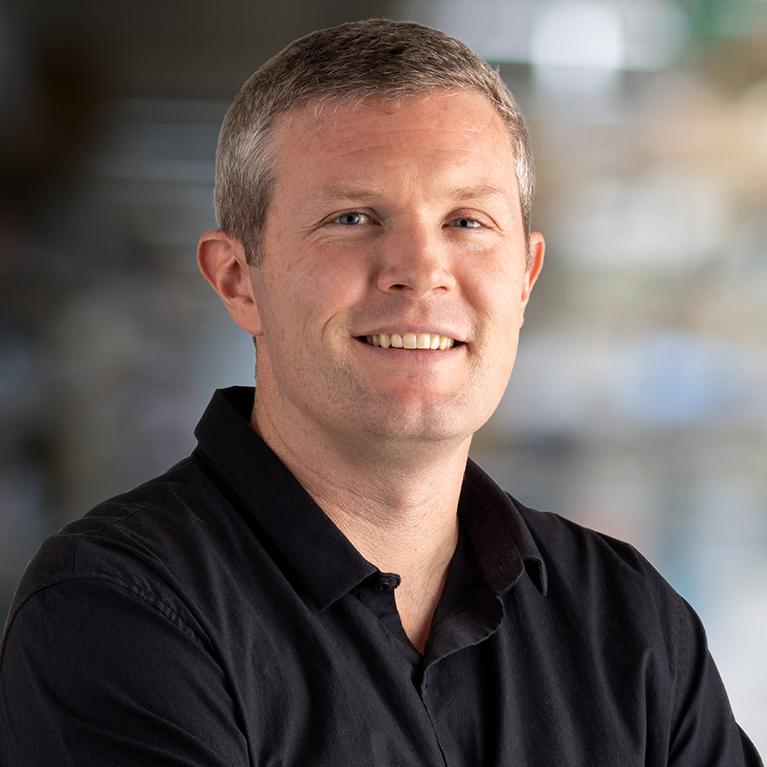
Jesse Dixon uses molecular and computational biology to explore how abnormal genome folding leads to errors in critical stretches of noncoding DNA that cause many diseases, such as cancer. He recently discovered that whether specific gene mutations cause cancer depends on the distance between a particular gene and the sequences that regulate the gene, as well as on the level of activity of the regulatory sequences involved. This work could help predict and interpret which genetic mutations found in cancer genomes are causing the disease.

Dannielle Engle, who has lost close family members to cancer, uses her personal and scientific passion, as well as her expertise in modeling, to facilitate progress in pancreatic cancer research by creating better representations of what actually happens in patients. In 2021, she was awarded the Lustgarten Foundation-AACR Career Development Award for Pancreatic Cancer Research in Honor of Ruth Bader Ginsburg. Engle is also part of a partnership between the Salk Institute and the Lustgarten Foundation focused on identifying and validating potential targets for new pancreatic cancer drugs. The $5 million effort also includes Professors Evans, Hunter, and Shaw.

Christina Towers uses a variety of techniques to uncover how cancer cells recycle both their own nutrients and the power-generating structures called mitochondria in order to survive. Her goal is to develop new targeted cancer therapies that can block the recycling pathways that allow these cells to survive. She has received several young investigator awards, including the Chan Zuckerberg Initiative’s Diversity Leadership Award and the Black in Cancer Young Investigator award, along with being named a Pew-Stewart Scholar for Cancer Research. These awards, totaling more than $1.6 million, will help Towers study the recycling process (called autophagy) and how cancer cells adapt when this pathway is blocked. (Read more about her lab’s work in Next Gen on page 42.)

Graham McVicker studies how human genetic variation affects gene regulation by combining experimental approaches with computational analyses. McVicker, the Frederick B. Rentschler Developmental Chair, is especially interested in identifying pathogenic regulatory variants that act in immune cells and cancer cells. In October 2022, he was one of 12 scientists (along with Professors Hunter and Shaw) to be named inaugural Discovery Grant winners by Curebound, a philanthropic organization dedicated to funding collaborative cancer research that has the potential to reach the clinic

Daniel Hollern merges two disciplines, computational medicine and cancer immunology, to find where tumors are vulnerable and how they can be controlled therapeutically by the immune system. In particular, his lab focuses on triple-negative breast cancer, where management of advanced disease is very challenging and for which he was recently awarded a Career Catalyst Research grant from the prestigious Susan G. Komen Foundation.
Other Notable Cancer Discoveries at Salk
- Leslie Orgel discovered a simplified and economical way to make Ara-C, a drug that prevents cancer cells from copying their DNA and dividing.
- Rudolph Janeisch created the first transgenic mouse, whose genome contained DNA from the SV40 tumor virus.
- Inder Verma pioneered stripped-down viruses to destroy cancerous cells and enhance healthy cells’ ability to fight cancer.
Conquering Cancer Initiative:
Five Ways to Eliminate the Disease
- Cut Cancer’s Fuel Supply – hit the metabolic Achilles’ heel
- Fight Fire with Fire – reduce inflammation to lower cancer risk
- Decode Cancer Genomes – discover the key genes to therapeutically target in each patient
- Mobilize the Immune System – turn suppressed immune responses into effective responses
- Re-engineer Therapeutics – use computational and systems approaches to identify optimal therapy combinations
To learn more, visit www.salk.edu/conquering-cancer-initiative
Support a legacy where cures begin.
Featured Stories
 Journey of a lifetime—The Cancer Center at Salk celebrates 50 years of life-changing discoveriesSalk’s Cancer Center has become a powerhouse of critical discoveries that have led to treatments and remissions for patients. The Center’s mission is to make current generations the last to see cancer as anything other than a routine diagnosis.
Journey of a lifetime—The Cancer Center at Salk celebrates 50 years of life-changing discoveriesSalk’s Cancer Center has become a powerhouse of critical discoveries that have led to treatments and remissions for patients. The Center’s mission is to make current generations the last to see cancer as anything other than a routine diagnosis.  Introducing Salk’s newest president, Gerald JoyceJoyce, a pioneer in the field of test-tube evolution, succeeds Professor Rusty Gage, who will return to his lab following a transformative leadership tenure. Joyce assumed the role April 21, 2023.
Introducing Salk’s newest president, Gerald JoyceJoyce, a pioneer in the field of test-tube evolution, succeeds Professor Rusty Gage, who will return to his lab following a transformative leadership tenure. Joyce assumed the role April 21, 2023.  Reuben Shaw—Unexpected resultsIt’s not every day a young scientist gets a jaw-dropping result he knows no one will believe. But that’s exactly what happened to Professor Reuben Shaw 20 years ago, in the spring of 2003.
Reuben Shaw—Unexpected resultsIt’s not every day a young scientist gets a jaw-dropping result he knows no one will believe. But that’s exactly what happened to Professor Reuben Shaw 20 years ago, in the spring of 2003.
 Tony Hunter—How an animal virus discovery more than 40 years ago led to one of today’s most successful cancer drugsThe story behind how Hunter discovered the first kinase that phosphorylates the amino acid tyrosine. The finding led to the development of Gleevec, a medication that is now routinely used to treat chronic myelogenous leukemia (CML).
Tony Hunter—How an animal virus discovery more than 40 years ago led to one of today’s most successful cancer drugsThe story behind how Hunter discovered the first kinase that phosphorylates the amino acid tyrosine. The finding led to the development of Gleevec, a medication that is now routinely used to treat chronic myelogenous leukemia (CML). Charles Stevens—A beautiful mind, and a heart to matchA pioneer in neuroscience, Distinguished Professor Emeritus Charles F. Stevens died peacefully on October 21, 2022, at his home in San Diego. He was 88.
Charles Stevens—A beautiful mind, and a heart to matchA pioneer in neuroscience, Distinguished Professor Emeritus Charles F. Stevens died peacefully on October 21, 2022, at his home in San Diego. He was 88. Leona Flores—Rocking cancer researchFlores had studied the design of the Salk Institute as an architectural engineering student, but never did she imagine that she would be the executive director of the Institute’s Cancer Center years later.
Leona Flores—Rocking cancer researchFlores had studied the design of the Salk Institute as an architectural engineering student, but never did she imagine that she would be the executive director of the Institute’s Cancer Center years later. Payel Mondal—Cancer researcher by day, financial planner by nightMondal is a postdoctoral researcher in Assistant Professor Christina Towers’ lab where she studies the mechanisms involved in cancer progression. Her hope is that her projects will someday be translated into therapeutics to help people.
Payel Mondal—Cancer researcher by day, financial planner by nightMondal is a postdoctoral researcher in Assistant Professor Christina Towers’ lab where she studies the mechanisms involved in cancer progression. Her hope is that her projects will someday be translated into therapeutics to help people. Salk receives $1.5 million from the Sol Goldman Charitable Trust and $1.25 million from The Jay and Sarah Flatley FoundationThe Salk Institute is grateful to its many generous supporters.
Salk receives $1.5 million from the Sol Goldman Charitable Trust and $1.25 million from The Jay and Sarah Flatley FoundationThe Salk Institute is grateful to its many generous supporters.
